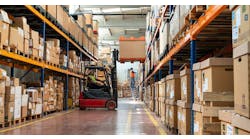After the unprecedented events of 2020, long-standing consumer behaviors have been forever changed—many of which have greatly impacted the material handling industry. Industries that have typically seen the majority of their business come from in-person transactions are starting to see a greater percentage of their revenue shift to e-commerce or are actively looking to mitigate risk by diversifying into e-commerce fulfillment.
Consumers are now loading their digital shopping carts with everything from groceries to medicine while expecting faster delivery at a lower cost. For instance, an estimated 3 billion packages made their way through the nation’s shipping infrastructure this past holiday season alone—about 800 million more than last year.
Due to this increased demand, warehouse inventory is expanding at an overwhelming rate, resulting in storage space constraints, picking errors and stocking inefficiencies. Now is the time for operations to invest in tactics like operator assist technologies to address these concerns and help their current labor force pick more accurately, comfortably and productively.
Leveraging Operator Assist Technologies
Order-picking is the most labor-intensive and costly activity for almost every warehouse, no matter the industry. In fact, up to 55% of warehouse operating costs and 70% of operating time are attributed to the order picking process. To address these challenges, it is important to recognize the opportunity for increased picking accuracy and evaluate which operator assist technologies best fit your operation.
An LED light system can streamline costly processes like searching for orders by directing operators to the correct customer pallet quickly and efficiently—enabling them to efficiently move to the next pick with confidence.
A pick-to-light system can increase operator proficiency, accuracy and productivity—ultimately assisting in the optimization process by creating efficient labor processes. A pick-to-light system can help reduce picking errors by using LED technology to visually reinforce product placement for order fulfillment in batch picking applications. The system can maximize operator productivity by integrating with the customer’s warehouse management system (WMS) or warehouse control system (WCS) and voice-pick receiver. The order-selectors are directed by the voice-pick receiver where to go, what part to pick, how many pieces to pick and for which customer order. Utilizing these combined technologies can greatly reduce user error and result in fewer mispicks.
By utilizing operator assist solutions, operations can optimize their operation by creating more space for product, increasing workforce productivity and leveraging lift trucks for the best suitable task—all of which, ultimately, drives cost savings.
Addressing the Labor Shortage
With increased demand comes a need for a more efficient workforce. In addition to operator assist technologies, operations should look for ways to enhance ergonomics and operator comfort to help retain skilled laborers and reduce turnover. The learning curve for new technology or equipment should be as small as possible to avoid costly delays. Investing in lift trucks that have intuitive control panels will make operators’ jobs much easier and can go a long way toward achieving operational efficiency.
Utilizing the right truck for the right application is always imperative. However, it takes proper training and confidence for operators to become comfortable and efficient with the task at hand. Proper ergonomics supports proper operation and can instill greater confidence.
Furthermore, innovative solutions such as virtual reality (VR) and e-learning modules have been proven to help operators reach higher operator proficiency levels faster and be coached more confidently. These data-driven solutions can immediately pinpoint weak areas, so administrators know who and when to re-teach and can better control the warehouse environment.
Rentals
With another record year of e-commerce on the horizon, operations need to prepare their fleets for unprecedented demand. For many, this will mean leasing new lift trucks and order-pickers. In today’s demanding material handling landscape, flexibility is vital, especially when it comes to sourcing and leasing equipment. Working with an OEM or dealer can help operations quickly add to their fleet and mitigate any adverse effects of quick growth.
It’s important to ensure you get the equipment and appropriate financing that meets your unique business needs. A few things to keep in mind when renting or leasing equipment:
Flexibility in changing out equipment. Companies often experience challenges as a result of not having an effective method for replacing their fleet over time.
The ability to consolidate payments into one invoice. Operations can simplify their finances and accounting by leasing with a company that combines a variety of different invoices into one lease bucket.
Easy returns at the end of a lease, with no additional cost. The common perception of leasing is that the end-of-lease process often turns out to be a real pain point for the lessee.
Embracing a Culture of Continuous Improvement
In recent studies, it’s estimated that 10 years of change have been compressed into just a few months as businesses and consumers have rapidly shifted buying patterns—increasingly turning to methods like e-commerce, which have placed a strain on the order-picking process. The cost of mispicks has large ramifications that affect your bottom line and have the potential to impact your customers’ satisfaction if there is an error in their order.When navigating today’s high-paced supply chain, addressing the labor shortage and investing in tactics like operator assist technologies and rental programs are vital to ensuring operations respond quickly and efficiently to consumers’ changing demands. Focus on optimizing your business to ensure processes are streamlined and productivity and efficiency remain high.
Erica Moyer is iWAREHOUSE product manager for RTLS, ObjectSense and Pick2Pallet with The Raymond Corporation (www.raymondcorp.com), a manufacturer of forklifts and material handling solutions.




